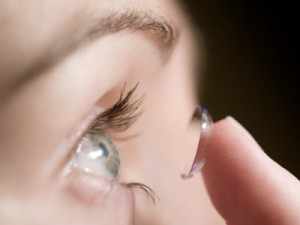Have you ever wondered what would happen if you wore your contact lenses overnight? Unexpectedly stayed the night at a friends house and didn’t have anywhere to put your lenses? Enjoying a late night and fall asleep with your contacts on?
It happens, contact lenses get worn too long and sometimes over night. Some contact lenses are better for this than others. I prescribe and fit people with the intention of overnight use. I also warn patients about the risks they are taking with their eyes.
Depending on the contact lens type and material, oxygen is reduced to the cornea. Movement of the contact with each blink aids the transmission of oxygen. When you are sleeping with the contact lens, the eye is closed and no oxygen gets to the cornea. There is no blinking either so the lens doesn’t move. The reduction in oxygen causes the cornea to swell, if the lens allows plenty of oxygen to get to the cornea during the day, the cornea will deswell and return to normal. However, if the cornea remains swollen, and you sleep in the lens consecutive nights, blood vessels will begin to grow into the cornea. Sometimes the eye responds by becoming inflamed, red and painful.
Another risk of leaving the lenses in overnight is infection. Typically when a lens is removed it is thrown away or placed in disinfecting solution. In the morning a new lens or a clean, disinfected lens is applied to the cornea. Microbials build up on a lens that is worn continually. If your cornea is compromised by a scratch or edema, the bacteria will infect the eye.
If you have been prescribed extended wear contact lenses, stay compliant to your wear schedule, once in awhile overnight or 6 consecutive nights. Clean and replace your lenses as prescribed. If you are wearing your daily wear contacts overnight, let’s talk about a safer option. This may include a higher oxygen material or even LASIK. Sometimes the prescription can be a limiting factor. If the prescription is higher, farsighted or is toric and corrects astigmatism, the lenses will be thicker and reduce oxygen transmissability.


